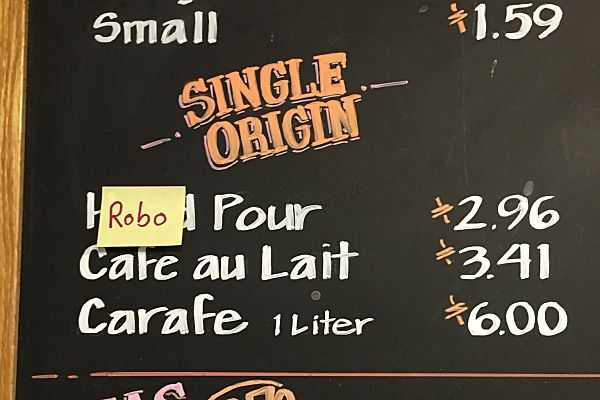by Tim Carman*
Joel Finkelstein didn’t replace his hand-pour stations at Qualia Coffee with a mechanical robot just to create a little cognitive dissonance. The bot-pour? He did it so you might reconsider your morning latte or that cup of batch-brewed coffee.
The Qualia owner knows you’re busy. He knows you can’t wait around 10 minutes, or more, for a barista to fuss over a hand-pour. But he hopes his new mechanical assistant called Poursteady, the first one in Washington, will pique your interest enough to ask the robot to make you a fresh cup of coffee.
“For me, the value of brewed-to-order coffee is so much more than house coffee,” Finkelstein says about that tower of mud that sits on the counter, awaiting customers every morning. “I would never order house coffee anywhere because I know it will have been sitting there for at least 20 or 30 minutes, for the most part, and it’s just not brewed as well.”
Finkelstein first heard about the Poursteady back in April when he met the company’s founders in Seattle at the Specialty Coffee Association of America’s annual expo. Finkelstein was impressed enough with Poursteady’s engineers (who have built robots for NASA and the U.S. Navy) that he pre-ordered the $12,000 machine while still in Seattle. (The system also requires the purchase of a Marco water boiler, an additional outlay of $3,000.)
“Joel was one of our first customers, and Qualia is definitely the only coffee shop in DC with a Poursteady,” e-mails Stephan von Muehlen, the company’s CEO.
The Poursteady system doesn’t replace the barista, Finkelstein is quick to point out. Baristas will still weigh out the beans, grind them and place them in the individual drippers. But the machine will take over from there. The Qualia team can program the Poursteady for every coffee available on the bar. They can program the amount of water poured, the time between each pour, the total number of pours and the pattern of each pour (wide radius, narrow radius, zig-zag motion, etc.).
Best of all, the machine can handle five pourovers simultaneously, even though it has only one water nozzle. The nozzle makes use of the lag time between pours to deal with other cups. The promise of the Poursteady, then, is consistency — at least once a barista has dialed in all the recipes, something that Finkelstein is still working on. Unlike a barista, who has to handle other transactions behind the counter, the Poursteady can focus exclusively on pouring water.
Oh, and the Poursteady doesn’t have its own smartphone to check every three minutes.
“The staff can focus on measuring the coffee,” Finkelstein says, “and interacting with customers, so they can help them pick a coffee. . . For people to choose wisely which coffee they want, that’s going to take staff time, and I’d rather have them doing that then sitting here and staring” at pourovers.
Another issue remains outstanding for Finkelstein: What do you call a hand-pour now? The coffee menu at Qualia, shown below, offers a temporary solution.
In other Qualia news: Finkelstein has pulled the plug on his planned location in an Ivy City project that also includes a beer garden and a specialized “bouldering,” or rock-climbing, gym.
“Basically, the bouldering gym kept absorbing more space until we were down to like 1,200 square feet, which wasn’t enough for us to do anything other than a coffee shop,” Finkelstein says. “I can’t roast out of there.”
But he says he’s now negotiating for a space in Eckington for a second coffee shop. Stay tuned.















